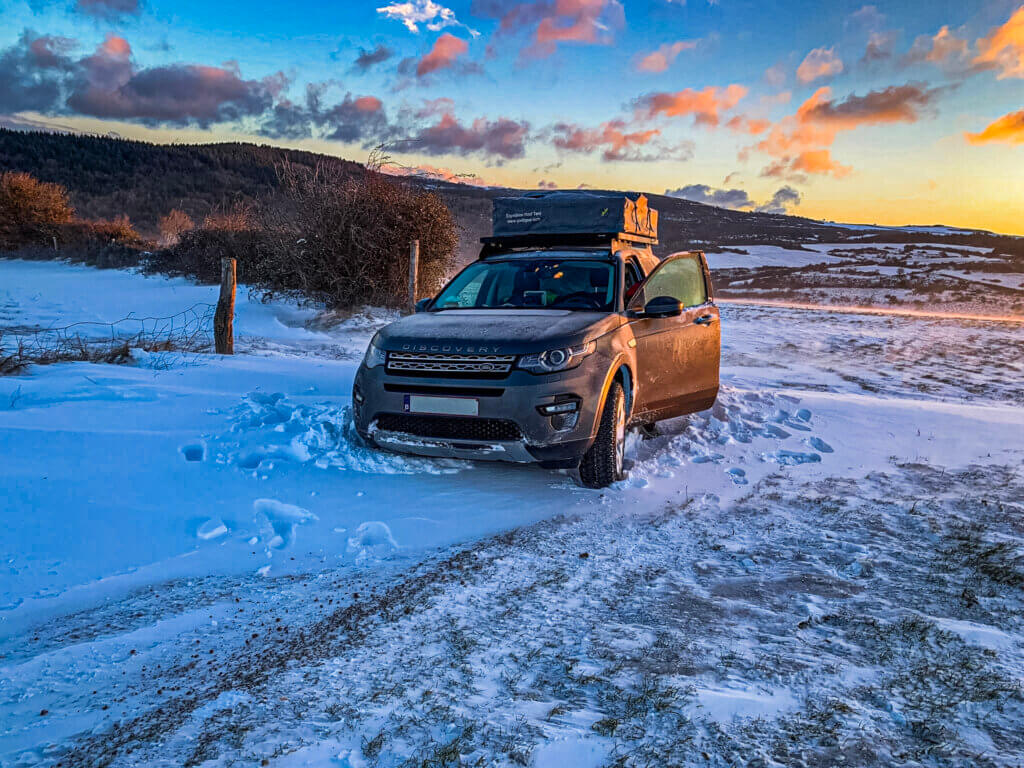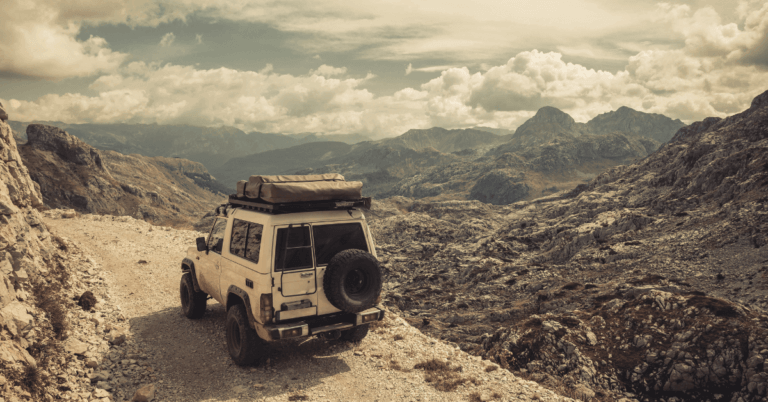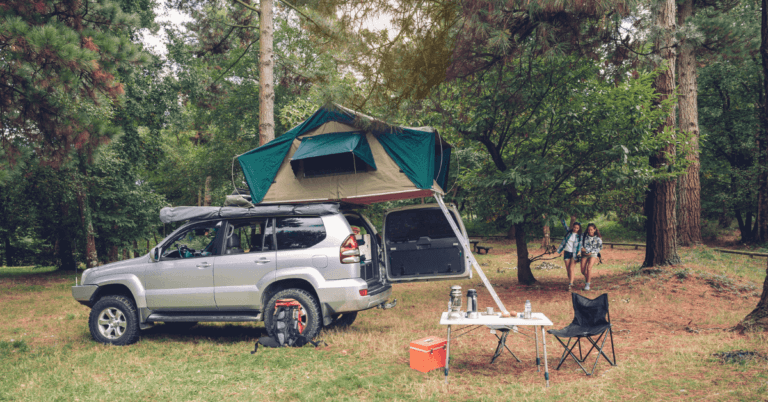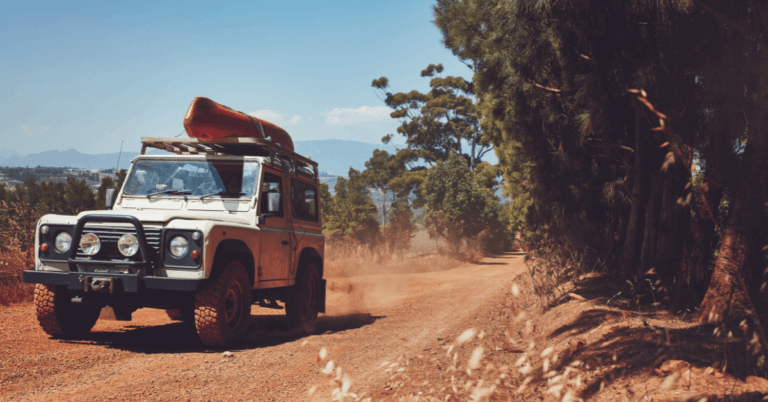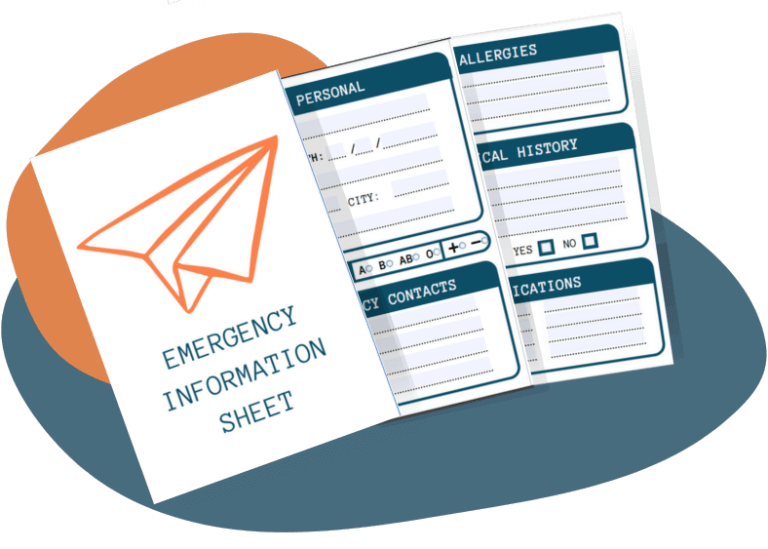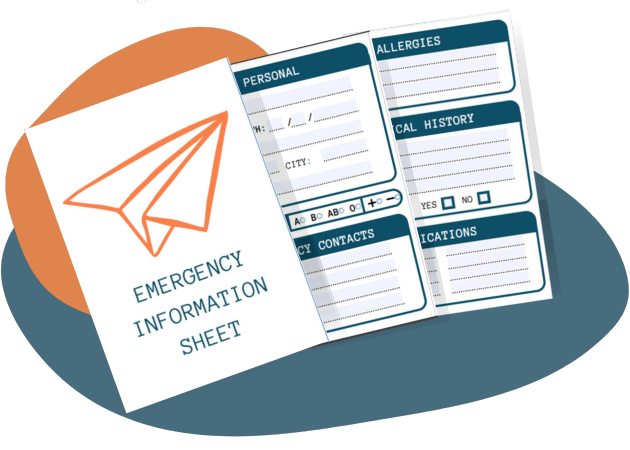Going on an overland journey through snowy landscapes, enjoying nature without big crowds, and roasting marshmallows over the campfire beneath starlit skies, sounds like pure magic! And it is, but as any seasoned winter camper knows, cold weather camping comes with some challenges.
Amidst the beautiful scenery and crackling fire, an invisible danger hides⏤hypothermia. The Wilderness & Environmental Medicine journal states that accidental hypothermia is one of the most common emergencies in the wilderness (Irwin, 2002). So preparing for it when you go winter camping is essential.
Keep reading to learn all about what hypothermia is, how to recognize it, and especially, how you can prevent it.
DEFINITION
Accidental hypothermia is defined as an unintentional drop in core temperature1 to 35°C or lower. Accidental hypothermia due to environmental exposure can occur during any season and in most climates, with cold and wet environments posing the greatest risk. (Lipman et al., 2019, p. S33-S46)
TYPES
Hypothermia is generally divided into three degrees of severity:
Mild hypothermia: core temperature 32-35°C
Moderate hypothermia: core temperature 28-32°C
Severe hypothermia: core temperature lower than 28°C
Cold-stress vs hypothermia
It’s important to know the difference between someone who’s feeling cold (core temperature >35°C) and someone who’s hypothermic.
If you do not have a thermometer with you, it is hard to spot the difference, since in both cases, the person can be shivering and have a mental status that’s still intact.
The easiest way to spot the difference is to look at the person’s ability to take care of themselves. If someone is unable to look after themselves, meaning that they are sitting or lying down, and are acting confused, it’s more likely that they’re mildly hypothermic rather than cold-stressed. If there is any doubt, treat it as mild hypothermia.
SYMPTOMS
Cold-Stressed
Someone who’s cold but not hypothermic will be conscious and alert. Their movement will be normal and they are most likely shivering. This defense mechanism will generate heat through the increased muscle activity.
Mild Hypothermia
Someone who is mildly hypothermic will be conscious and alert, but their movement will be impaired, leaving them unable to care for themselves.
In addition to shivering, cold diuresis2 can appear. Due to the cold, the body’s vessels will constrict. The resulting excess of fluids in the body will be compensated by the kidneys extracting more fluid from the blood, resulting in a full bladder.
Moderate Hypothermia
There will be less to no shivering since this usually stops when the core temperature decreases to approximately 30°C, resulting in further heat loss.
The brain will cool which can result in poor decision-making and the person being irritable, confused, apathetic, and sleepy.
The heart will cool, which will slow the heartbeat and lower blood pressure, resulting in less blood being pumped throughout the body and an increased risk of developing an abnormal heart rhythm. The breathing will slow.
Severe Hypothermia
As the brain keeps cooling, eventually the person will go into a coma.
If the heart keeps cooling, ventricular fibrillation3 can occur, characterized by an irregular heartbeat and an inability to pump blood through the body. This will result in the person becoming unconscious, and without immediate medical intervention, will lead to death.
Severe hypothermia is very difficult to differentiate from moderate hypothermia out in the field. The general recommendation is that if someone is cold and unconscious, it’s safe to assume they are severely hypothermic.
MECHANISM
To understand how to prevent hypothermia, let’s first explore how the body regulates its temperature.
Heat Loss
As the Clausius Statement says: “If there’s a difference in temperature between two neighboring objects, heat will always flow from the one with a higher temperature to the one with the lower temperature.” This heat exchange can not be eliminated, but it can be slowed (Kosiński et al., 2022, p. 134-139).

To know how we can best prevent heat loss, we need to understand the four ways in which the body can lose heat: conduction, convection, evaporation, and radiation.
Conduction happens when there’s physical contact with a cold object, like sitting on a cold floor. Convection occurs when you lose heat due to air movement, like wind. Due to evaporation, you lose heat when your skin is wet. The body radiates heat, and due to this radiation, you will lose heat in a colder environment.
Thermoregulation
The body is constantly working to keep its core temperature around 37°C. When it loses heat, it will try and retain heat by constricting the vessels, and it will produce heat by shivering. This is exhausting for the body and consumes a significant amount of energy.
PREVENTION
Shelter
You want to get away from the floor as much as possible, since sleeping on a cold surface will make you lose body heat due to conduction. You can prevent this by placing a foam pad (at least 1.5cm thick) under your sleeping bag, opting for a rooftop tent, or sleeping inside your car.
Heating
It is recommended to camp where you are allowed to start campfires. These can be true lifesavers when it comes to those frisky nights, and can even be used to cook. You can find some tips on how to start your campfire here.
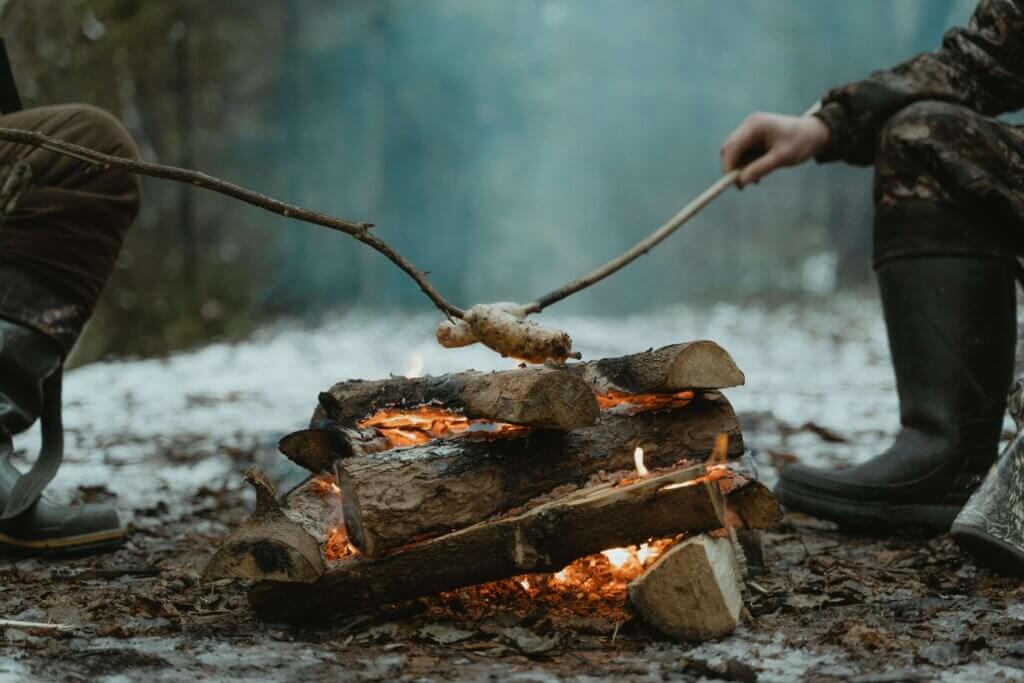
If you are going winter camping in extremely low temperatures, it’s safest to invest in a heater for your camper or tent. This way you know you’ll always have the option for some emergency heat when needed.
Sleeping
A sleeping bag, preferably hooded, will keep you warmer than normal blankets since it surrounds your whole body and less heat will be able to escape.
Make sure to go for one that is fabricated for lower temperatures than you intend to encounter, and ensure that it has a snug fit. When it’s too big, your body heat might convect to the trapped air in your sleeping bag, which will result in you getting cold.

If there is too much space in your sleeping bag, you can keep yourself warm by filling up the gap with additional layers of clothes.
If you prefer a blanket or duvet over a sleeping bag, you might want to invest in a heated blanket. Make sure the battery will last you several hours so you can get through the night without getting cold. We recommend the Zonli Heated Blanket, which will keep you warm for 7.5 hours.
Clothes
Proper clothing is an absolute must when it comes to winter camping. The insulation a garment offers will depend on how much air it can trap close to the body.
Clothes that are too tight won’t be able to keep as much air in, which doesn’t make them a good choice for cold weather.
Material
Both wool and fleece are both suitable materials for cold weather. Which one is better for you depends on your planned activities and environment.
Fleece gets wet faster than wool, leading it to lose heat faster initially. However, it does dry faster than wool.
Wool stays drier and warmer for longer, but once it gets soaking wet, it will take a long time to dry. Wool does offer more protection from wind.
In rainy or snowy conditions, adding a water- and windproof outer layer is essential.

Stay away from cotton! It absorbs moisture and traps it against the skin, providing no insulation.
Layers
It’s essential to layer your clothes to get optimal insulation. Opt for a wool base layer, a wool or fleece middle layer, and a wind- and waterproof outer layer. A wool beanie, socks, and mittens prevent you from losing body heat through your extremities.
Remove wet clothes
Due to evaporation, wet clothes make you lose heat 5 times faster than when you’re wearing dry ones. Carry a spare dry outfit to change into if your clothes get wet.
Removing extra layers of clothing may be advised if you start to sweat since this can result in your clothes getting wet as well.
Food
In a cold environment, the body needs extra calories to make up for the energy needed to keep the body warm, especially when you start shivering. Make sure to take this into account when you planning how much food to pack for your trip, so you can keep yourself well-nourished.
Keep your water inside your vehicle when possible, so it doesn’t freeze. If you were to end up without drinkable water, avoid eating snow, since your body will use up a lot of energy melting it into a liquid. Instead, opt for melting snow first over a fire or inside your car.
TREATMENT
To decide which treatment the person needs, we will first have to determine whether they’re cold-stressed, mildly, moderately, or severely hypothermic. The distinction is based on the symptoms that occur with each of these.
A thermometer can help rule out hypothermia, but it isn’t recommended to be used as the only determining factor for the severity of the hypothermia. Even if you have a digital thermometer, results can be unreliable when it comes to very low temperatures.

If you do have a thermometer on hand, make sure to check the temperature orally since this closely resembles the core temperature.
Cold-Stressed
The main objective of helping a cold-stressed person is to prevent heat loss. Make sure to replace wet clothes with dry ones, support shivering by giving them high-calorie food and drinks, and move them to a warmer place, like a car, if possible.
The distinction between someone who is cold-stressed and mildly hypothermic can be difficult to make, so if there’s any doubt, starting treatment for mild hypothermia is advised.
Mild Hypothermia
- For mildly hypothermic patients, passive rewarming4 is generally appropriate due to an intact thermoregulatory response.
- In many cases, providing shelter, insulation, and shivering support is sufficient.
Observation
If someone is suspected to be hypothermic and is lying down, it is recommended to observe them for 30 minutes before allowing them to stand up.
During this observation period, take measures to prevent further heat loss by removing wet clothing, insulating the person, and supporting shivering.
This 30-minute observation is crucial to prevent afterdrop. Afterdrop occurs when a person’s temperature continues to drop, even after they have left the cold environment.
It is believed to happen due to conductive heat loss from the warmer core to the cooler peripheral tissue and convective heat loss from blood as it returns to the heart after flowing through cooler parts of the body
Prevent Heat Loss
Remove wet clothes
Removing wet clothing is essential to prevent further heat loss and should be done gently. If the person is lying down, cut off the wet clothes rather than letting them stand up to remove them.
Insulation
To retain the generated heat, it is essential to adequately insulate the patient from the environment. This is particularly crucial during transport to a warmer environment or while waiting for assistance.
Shield the person from the wind by positioning them behind a tree or large rocks, sheltering them in a tent or vehicle, and covering their upper body, head, and neck with a hood, jacket, or blankets to prevent convective heat loss.
Additionally, placing them in a foam pad or blanket can insulate them from the ground, which will avoid conductive heat loss.
Rescue Blanket
Wrapping a person in a rescue blanket prevents the loss of the body’s produced heat. To enhance insulation further, you can wrap an additional blanket over the foil or place the person in a sleeping bag.
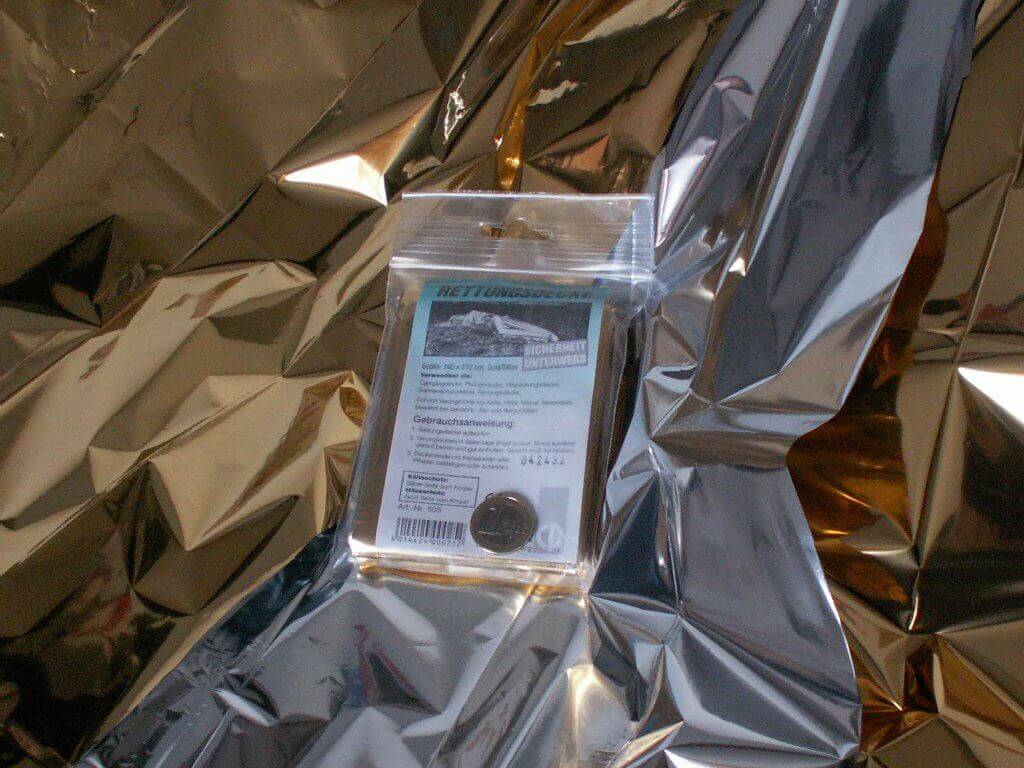
Rescue blankets are polyethylene terephthalate foils coated with a thin aluminum layer. They’re characterized by their silver and gold surface and prevent heat loss by radiation, offer shelter from rain and wind, and lessen heat loss by evaporation by keeping the air surrounding the skin humid.

Never apply the emergency blanket directly on the skin! It can heat up and cause burns. Leave on the base layer of clothing, replacing it with dry clothing if it’s wet.
Gold is cold?
It is widely believed that the gold side should be facing outwards when you’re trying to warm up. However, a 2020 study by Kranebitter et al. showed that there isn’t a significant difference between putting the gold side or the silver side up when it comes to treating hypothermia.
The study does advise putting the silver side up when the weather is windy or wet, or when you’re trying to protect yourself from the sunlight. In an emergency, the gold side up is advised when you’re in the snow, because it increases visibility.
Passive Rewarming
Support Shivering
If the person is alert and not vomiting, support their shivering by providing calorie-dense food and drinks. When warming them, ensure the temperature is moderate to prevent burns.
Drinking hot beverages is beneficial for rewarming and helps prevent dehydration resulting from cold diuresis. However, avoid highly caffeinated drinks like coffee and tea, as they stimulate diuresis, leading to further dehydration.

Never give alcohol to someone who is hypothermic! Alcohol lowers the shivering reflex, accelerating the cooling process.
Exercise
After 30 minutes, if the person is alert, they can attempt to stand up, gradually increasing exercise. If the condition worsens, stop the exercise.
Body-to-Body Warming
Shivering can cause a lot of discomfort for a person. Body-to-body rewarming5 can help relieve this, but it doesn’t rewarm the person quicker than shivering alone.
Avoid Warm Shower/Bath
A warm shower or bath should not be used for initial rewarming, even if a patient appears to be only mildly hypothermic. This will increase the blood flow, causing a higher risk of afterdrop.
If the person’s condition or temperature does not improve with the previous steps, active rewarming6 becomes necessary, and evacuation is required.
Moderate and Severe Hypothermia
The chances of someone being successfully rewarmed in the field are slim, so make sure to call for help immediately when you suspect someone to be moderately to severely hypothermic.
When the body cools below 32°C, it won’t shiver anymore and thermoregulation will be insufficient, making active rewarming necessary.
The person should be evacuated as quickly as possible, so calling for medical aid is the absolute priority. While you’re waiting for help, preventive measures like wrapping the person with an emergency blanket for insulation, removing their wet clothes, and warming them with layering clothes or blankets.

Make sure not to give them any food or drinks! Their consciousness may vary, causing them to choke.
When you suspect someone to be moderately to severely hypothermic, it’s extremely important to handle them gently. They shouldn’t be allowed to stand or walk around.
Try to move them as little as possible, since movement could induce ventricular fibrillation. If their clothes are wet, instead of moving the person to remove them, cut them off.
If the condition of the person deteriorates, and they become unresponsive, their breathing is abnormal or absent, or a pulse can no longer be felt, CPR7 (cardiopulmonary resuscitation) should be started immediately.
SUMMARY
As you get ready for your winter camping escapade, keep in mind the magic of snowy landscapes also comes with its challenges. Knowing how to prevent hypothermia is your ticket to a safe and carefree trip.
Remember the importance of shelter, heating, proper clothing, and staying well-nourished. Whether you’re roasting marshmallows over a campfire or bundled up in a sleeping bag beneath the starlit skies, the beauty of winter camping lies in the balance between thrill and caution.
as you venture into the winter wonderland, be prepared, stay warm, and most importantly, have a safe and joyful winter camping experience!
〰
Sources
Haverkamp FJC, Giesbrecht GG, Tan ECTH. The prehospital management of hypothermia – An up-to-date overview. Injury. 2018 Feb;49(2):149-164. doi: 10.1016/j.injury.2017.11.001. Epub 2017 Nov 4. PMID: 29162267.
Henriksson O, Lundgren P, Kuklane K, Holmér I, Naredi P, Bjornstig U. Protection against cold in prehospital care: evaporative heat loss reduction by wet clothing removal or the addition of a vapor barrier–a thermal manikin study. Prehosp Disaster Med. 2012 Feb;27(1):53-8. doi: 10.1017/S1049023X12000210. Epub 2012 Mar 23. PMID: 22445055.
Institute of Medicine (US) Committee on Military Nutrition Research. Nutritional Needs In Cold And In High-Altitude Environments: Applications for Military Personnel in Field Operations. Marriott BM, Carlson SJ, editors. Washington (DC): National Academies Press (US); 1996. doi: 10.17226/5197. PMID: 25121290.
Irwin BR. A case report of hypothermia in the wilderness. Wilderness Environ Med. 2002 Summer;13(2):125-8. doi: 10.1580/1080-6032(2002)013[0125:acrohi]2.0.co;2. PMID: 12092964.
Kosiński S, Podsiadło P, Darocha T, Pasquier M, Mendrala K, Sanak T, Zafren K. Prehospital Use of Ultrathin Reflective Foils. Wilderness Environ Med. 2022 Mar;33(1):134-139. doi: 10.1016/j.wem.2021.11.006. Epub 2022 Jan 5. PMID: 34998706.
Kranebitter H, Wallner B, Klinger A, Isser M, Wiedermann FJ, Lederer W. Rescue Blankets-Transmission and Reflectivity of Electromagnetic Radiation. Coatings. 2020; 10(4):375. https://doi.org/10.3390/coatings10040375
Lipman GS, Gaudio FG, Eifling KP, Ellis MA, Otten EM, Grissom CK. Wilderness Medical Society Clinical Practice Guidelines for the Prevention and Treatment of Heat Illness: 2019 Update. Wilderness Environ Med. 2019 Dec;30(4S):S33-S46. doi: 10.1016/j.wem.2018.10.004. Epub 2019 Jun 17. PMID: 31221601.
Phillips D, Bowman J, Zafren K. Successful Field Rewarming of a Patient with Apparent Moderate Hypothermia Using a Hypothermia Wrap and a Chemical Heat Blanket. Wilderness Environ Med. 2019 Jun;30(2):199-202. doi: 10.1016/j.wem.2019.01.001. Epub 2019 Feb 26. PMID: 30824366.
- The internal temperature of the body, usually referring to the temperature of the vital organs. ↩︎
- Increased urine production due to exposure to cold, caused by blood vessel constriction and fluid retention by the kidneys. ↩︎
- A life-threatening heart rhythm disorder. ↩︎
- Allowing the body to naturally rewarm itself. ↩︎
- Using body heat from another person to rewarm someone ↩︎
- Applying external heat sources to raise the body temperature. ↩︎
- CardioPulmonary Resuscitation: Emergency procedure involving chest compressions and artificial ventilation to maintain blood circulation and oxygenation. ↩︎


